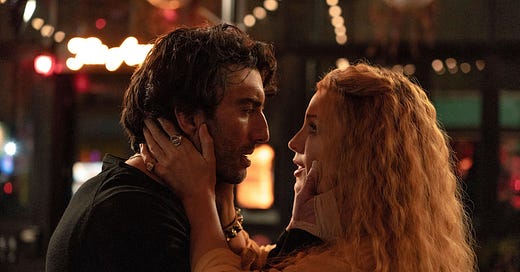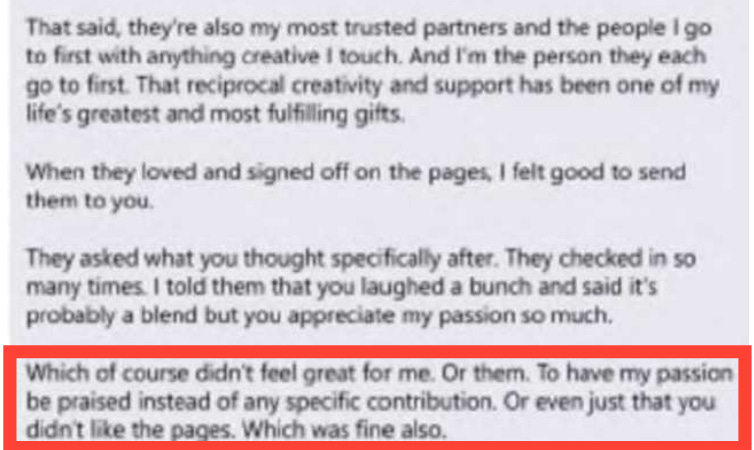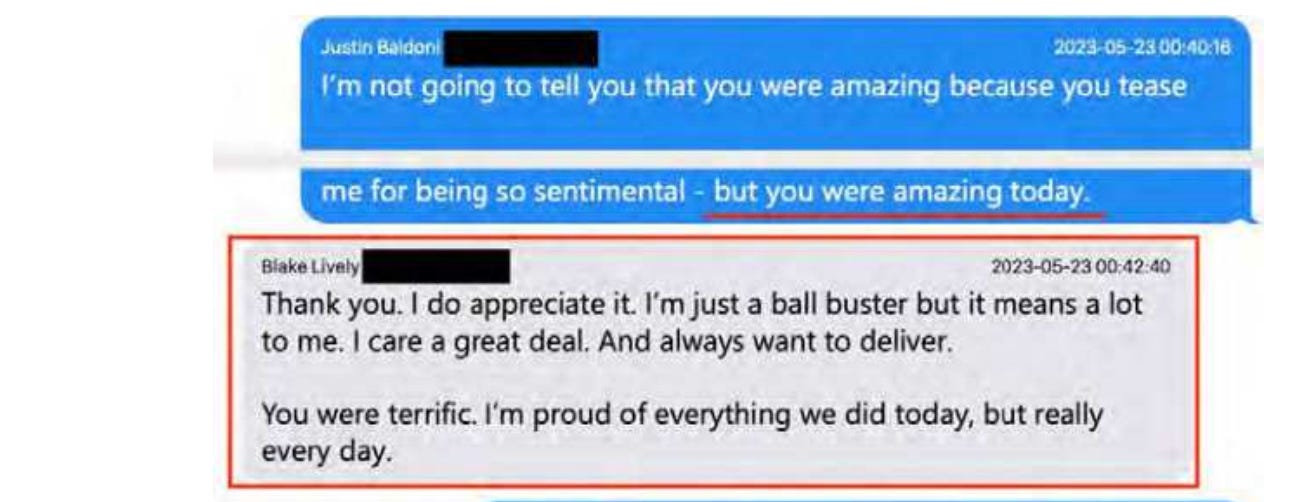It Ends With Power
TL;DR: The It Ends With Us drama isn’t just celebrity gossip—it’s a case study in how power is covertly claimed, defended, and weaponized by institutionalized power-holders in workplaces everywhere.
In recent months, drama from the filming of It Ends With Us spilled into the headlines. Blake Lively and Justin Baldoni filed dueling lawsuits accusing one another of sexual harassment, retaliation, extortion, and defamation, with on-set videos, texts, and voice memos leaked to the media. The public discourse around this dispute has focused almost exclusively on getting at the truth, with the evidence often serving as a Rorschach test for preexisting convictions. However, as a work scholar, I think what’s more revealing about this controversy—and more important for understanding—is how it illuminates power dynamics in the workplace.
My goal for this newsletter is to break down everyday workplace situations, identifying the subtle dynamics of power and inequality most of us have experienced but which are often hard to articulate. These situations are complex and nuanced, in no small part because they are less a function of the intentions of individual actors than the social systems in which they operate. I aim to provide readers with a map revealing how well-meaning actions can go awry, how workplace dysfunction perpetuates, and how we sometimes even participate in our own undoing. By equipping readers with this understanding, I hope to help people better navigate work life while offering perspective, knowledge, and empathy. Through naming locations and narrating routes along this map, I provide the tools for questioning taken-for-granted workplace experiences and creating new labor pathways.
While the Lively/Baldoni controversy may seem far afield – tales from an alternate reality experienced only by the rich and famous – the intensity, complexity, and emotional toll of navigating workplace relationships is likely familiar. How many of us have lost sleep replaying an uncomfortable conversation at work? Poured our frustrations out to friends or family about that overzealous, oblivious, or offensive coworker or boss? Or quietly sketched out a “Plan B,” bracing for the day our professional world might come crashing down? Perhaps it is the run-of-the-mill ordinariness of this situation that has (mis)led us to the all-too-familiar “he said/she said” narrative dominating the discourse.
I offer a different vantagepoint for exploring this conflict – one that traverses the landscape of power. At first blush, Baldoni appears as the obvious underdog because he is not a name-brand celebrity. As Allie Jones dismissively noted in her newsletter, “He was on Jane the Virgin? Maybe your older sister watched that in 2015?” Compared to Lively – a broadly-recognized Hollywood star married to a well-known actor/producer/soccer mogul (Ryan Reynolds) and best friends with arguably the most famous celebrity of our era (Taylor Swift) – Baldoni's relative obscurity seems to place him at a disadvantage. Yet, this view of power as solely an individual attribute fails to take into account how power is sourced from multiple levels, including workplace roles, occupational structures, and societal norms. Indeed, a close reading of Baldoni’s lawsuit reveals not a Hollywood diva run amok, but a masterclass in how power is quietly claimed, defended, and weaponized by institutionalized power-holders – both in Hollywood and workplaces everywhere.
Obscuring Power Through “Collaboration”
When Baldoni stepped onto the set of It Ends With Us, he assumed considerable workplace authority. He was the film’s director, executive producer, and co-chairman of Wayfarer Studio, which owns the rights to the novel (and its sequel) and funded and oversaw production. But authority is a funny thing; when exerted overtly, it often provokes pushback rather than compliance. As workplace leaders across sectors have learned, it’s more effective to get people to “buy in” and voluntarily invest their time, energy, and emotion. Baldoni followed this script, promising close collaboration when Lively expressed concerns about the magnitude of his power:
For her part, Lively appears to have taken Baldoni at his word. Her subsequent actions – requests to revise a key rooftop scene in early April 2023 (pre-production) and later to access to the dailies (raw footage) – suggest she understood his offer as genuine partnership:
Note: All text messages are sourced from Baldoni’s filing documents, and their resolution depends on their quality within those documents.
However, limits to this promised collaboration emerged from the jump. When Lively sought to negotiate a producer role on the film during sign on, Baldoni and Wayfarer “demurred, given that such a title would not accurately reflect the role she was asked to play in the production” (p. 18 of Baldoni’s amended complaint). Baldoni clearly had a hierarchy in mind, and this was his first move to defend it.
Was Lively simply naïve to the difference between Baldoni’s rhetoric and reality? Most bosses promote a collaborative culture, but very few invite you into the boardroom. Or did she – as Baldoni claims – abuse his disarming invitation, using it to run roughshod over his authority and undermine his creative vision?
Such an allegation loses its teeth when contextualized within the male-dominated industry in which both Baldoni and Lively work. And make no mistake, the US film industry is male-dominated: 75% of the top-grossing films of 2023 employed 10 or more men as directors, writers, producers, executive producers, editors, and cinematographers, while just 4% employed 10 or more women in those roles. In texts to Baldoni, Lively provides insight into the everyday realities of navigating this power imbalance, describing a history of contorting and censoring herself.

In another text, Lively reflects, “I’m not always good at making sure I’m seen and utilized for fear of threatening egos, or fear of affecting the ease of the process,” (p. 22 of Baldoni’s amended complaint). Her words hint at a fear of being labeled as “difficult” – a Scarlett Letter used to brand Hollywood women who dare to assert themselves. Ironically, despite her attempts at diplomacy, Baldoni’s complaint indicates she was already marked.
The entrenched nature of women’s subordination in Hollywood is painfully evident in yet another text, where she acknowledges that maintaining her appearance is “my job here”—a blunt admission that her body is deemed central to the performance. It’s a stark reminder that, in this male-dominated industry, women’s aesthetic value is often prioritized over their creative contributions.
The push-and-pull between Lively and Baldoni played out on a steep incline—Baldoni holding the rope just taut enough to keep Lively edging upward but slack enough that she could never reach the top. When Lively sent her edits on the rooftop scene, for example, Baldoni “thanked Lively for her passion and diplomatically told her that the scene would likely end up being somewhere between the original version and Lively’s version” (p. 22 of the amended complaint). Indeed, he repeatedly denied her tangible contributions and credit, limiting her agency and reasserting the status quo hierarchy.
Lively’s disillusionment is palpable in a text message to Baldoni regarding the roof scene. She immediately recognizes his praise of her “passion” as brushing off her creative input:
At this point, Lively is said to have turned to her infamously-coined “dragons” – Reynolds and Swift – for support. But drawing on one’s social capital from a subordinated position is a fool’s errand. Any support given from others – no matter how powerful – risks undermining their own merit. In a field where women’s contributions are already undervalued and denied legitimacy, Lively’s reliance on her social network became another avenue for discrediting her agency and power—framing them as borrowed rather than earned. This dynamic echoes the derogatory trope of women 'sleeping their way to the top,' a sexist narrative that reduces women’s achievements to their relationships rather than their abilities.
Baldoni Flexes His Muscle
By June 2023 Baldoni had transitioned to a more offensive position, backchanneling with producers and editors to discredit Lively’s actions. Framing her as overstepping, he mounted a covert, preemptive strike – a classic maneuver from those in power. We’ve seen it before: Ashley Judd and Mira Sorvino were marginalized after rejecting Harvey Weinstein’s advances; Ellen Pao became a target of gossip after challenging gender discrimination in Silicon Valley. The playbook is the same—close ranks, neutralize the threat, and protect the hierarchy.
This is around the time that production started and the alleged harassment by Baldoni and Wafarer co-founder Jamey Heath began. The timing is important, as other research reveals men often resort to harassment when their power feels threatened. We can’t know their intentions in this case, but the alleged behavior included Baldoni improvising intimacy scenes, Heath entering Lively’s trailer while she was nursing, showing her a video of his wife giving birth, and Baldoni commenting on her looking “sexy” on set—all acknowledged, though dismissed, in Baldoni’s filing. The filing also notes that Lively raised concerns with a Sony executive before addressing Baldoni and the producers directly—a courtesy he failed to extended to her, opting for backchanneling instead. After a break for the writer and actor strikes, Lively returned with a 17-point list of non-negotiable conditions, citing these earlier incidents.
And this is where Baldoni – a self-proclaimed feminist ally – truly begins to flex his muscle. In his 2017 TED Talk, “Why I'm Done Trying to be ‘Man Enough,’” he challenged other men:
Are you confident enough to listen to the women in your life? To hear their ideas and their solutions? To hold their anguish and actually believe them, even if what they're saying is against you?
Ironically, his own response does not model such confidence. In his filing, Baldoni repeatedly downplays Lively’s complaints, deflecting them with accusations of mixed messages and double standards. He claims, for example, that she “refused to meet with the intimacy coordinator” but only cites her declining a single pre-production meeting, noting she preferred to meet on set. He also dismisses Lively’s discomfort over Heath’s invasion of privacy by pointing to a separate instance where she invited Baldoni into her trailer while nursing. Both defenses rest on false equivalencies that distort the nature of consent. Consent given once doesn’t settle the question of boundaries—nor does it leave the door open for anyone, at any time, to walk through.
Baldoni also points to Lively’s use of the word “ballbuster” in self-deprecating text and “sexy” in wardrobe discussions, using these examples to illustrate what he calls a double standard. This comparison, however, fails to recognize how her language reflects an attempt to strategically navigate a male-dominated space, and how that usage is different than him talking about porn or commenting on her appearance (examples from Lively’s complaint) from a position of authority where rebuttal risks retaliation.
A final illustration of the gap between Baldoni’s public ideals and private actions emerges in his response to Lively’s characterization of their relationship and the on-set culture. Casting Lively as a liar, he points to complimentary remarks from other cast members and his ongoing friendly conversations with Lively in particular. To wit, he cites her knowing his tea order as proof of positive rapport—seemingly blind to how workers often track their supervisors’ preferences out of professional necessity. What he crucially misses is how power dynamics create a false feedback loop, where a subordinate’s attentiveness is misread as intimacy and care.
While Baldoni might be seen as a failed ally—someone who aspires to challenge the status quo but falters in execution—his actions suggest something more deliberate and pernicious. Indeed, he leaned heavily into misogynistic tactics when mounting his defense against an anticipated attack from Lively. In June 2024, he hired the crisis communications firm The Agency Group PR LLC (TAG) — the same firm that represented Johnny Depp during his defamation trial against Amber Heard’s allegations of domestic abuse and was allegedly instrumental in stoking what became “a public orgy of misogyny” in the public discourse surrounding it (particularly online). In the context of his own sensitivity to the promotion of alcohol products alongside their film about domestic violence (a crime often exacerbated by alcohol use), it’s hard to believe that someone so attuned to media optics would make this choice by accident.

Moreover, rather than distance himself from toxic narratives, Baldoni’s filing is riddled with sexist dog whistles, portraying Lively through a familiar set of stereotypes such as conniving, power-hungry, frivolous, and financially irresponsible.
The irony is palpable: Baldoni has built his personal brand on understanding gender politics. He knows the burden of women’s constant hypervigilance (e.g., p. 160 of his book). He knows women must fight to be heard. He knows the danger of stereotypes.
The dynamics playing out between Baldoni and Lively may seem like Hollywood spectacle, but they are deeply familiar to anyone who has navigated power struggles in the workplace. The tactics—false promises of collaboration, backchanneling to discredit perceived threats, and leveraging gendered stereotypes to maintain control—are not unique to the film industry. They happen in offices, startups, universities, and boardrooms every day.
This is exactly what this newsletter is about: unpacking the hidden mechanisms of power at work and making them visible so we can better understand (and challenge) them. As a sociologist, I’ve spent over a decade researching workplace dynamics. During that time, I’ve analyzed national and organizational survey data, interviewed more than 200 professionals across various roles, and immersed myself as a participant observer in diverse workplaces—from ride-hail circuits to restaurants to professional offices. I’ve developed a keen ability to identify and dissect the subtleties of work relationships and interactions, the hidden dynamics of workplace cultures, and the systemic forces that shape our everyday work lives and career trajectories.
In future issues, I’ll dissect workplace quandaries – many taken from my own research data – to explore the power struggles, unspoken rules, and fraught negotiations within modern work. Because while Hollywood cases like this might magnify these dynamics, they are anything but extraordinary.





















This was so interesting. Would love a follow-up on this to outline how someone in Lively's position could fairly juggle the drive for collaboration/input with the pushback she received. More ways to challenge/solve this please!
This was an awesome read. I can’t wait to read the next one!